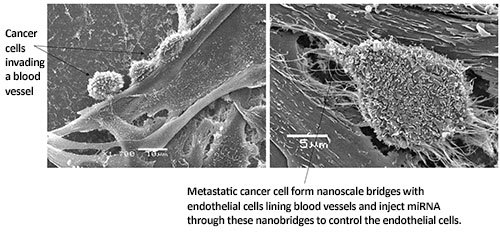Breast Cancer
Defining the Role of Nanoscale Membrane Bridges in Metastatic Breast Cancer



Posted February 9, 2016
Shiladitya Sengupta, Ph.D., Brigham and Women's Hospital
 More than 90% of breast cancer mortalities are associated with cancer metastasis, a major hurdle in the search for a cure. Metastasis involves a cascade of processes including invasion and intravasation of tumor cells, survival in circulation, extravasation, and metastatic colonization. A more in-depth analysis of communication between tumor cells and vascular endothelium in the context of metastasis, primarily during extravasation, is greatly needed. Nanoscale intercellular membrane bridges act as physical conduits for transferring miRNAs, which is thought to aid in the process of metastasis. By targeting these membrane bridges through pharmacological inhibition, new treatment methods may be possible for breast cancer patients.
More than 90% of breast cancer mortalities are associated with cancer metastasis, a major hurdle in the search for a cure. Metastasis involves a cascade of processes including invasion and intravasation of tumor cells, survival in circulation, extravasation, and metastatic colonization. A more in-depth analysis of communication between tumor cells and vascular endothelium in the context of metastasis, primarily during extravasation, is greatly needed. Nanoscale intercellular membrane bridges act as physical conduits for transferring miRNAs, which is thought to aid in the process of metastasis. By targeting these membrane bridges through pharmacological inhibition, new treatment methods may be possible for breast cancer patients.
With funding from an FY13 BCRP Breakthrough Award, Dr. Shiladitya Sengupta is exploring the understudied area of communication between tumor cells and endothelium. In a recent publication in Nature Communications, Dr. Sengupta has reported on the preferential formation of nanoscale intercellular membrane bridges between metastatic cancer cells and endothelial cells. Experimenting in vitro on a three-dimensional tumor matrix, Dr. Sengupta found that interactions between metastatic cancer cells and endothelial cells can create a "niche" that facilitates an invasive phenotype. Using scanning electron microscopy (SEM), he observed that this phenotype was characterized by the cancer cells preferentially binding to the vascular network, becoming elongated and invaginating into the endothelial network. About 70% of these cancer cell-to-endothelium bridges were found to be comprised of actin supported by tubulin cytoskeletal components. The periodic presence of the Myosin V motor protein suggested that these nanostructures could possibly function as an intercellular "highway" connecting cancer cells and endothelium. Through an evaluation of the kinetics of formation, Dr. Sengupta showed that the structures occurred in a directed non-stochastic manner, pointing to a functional role. These bridges also act as conduits through which miRNAs can be transferred from the cancer cells to the endothelium. The ability to form nanoscale conduits with endothelial cells was found to correlate with the metastatic potential of the cancer cell. Dr. Sengupta also investigated the pharmacological effects of docetaxel combined with latrunculin A or cytochalasin D. Both drug combinations disrupted the formation of heterotypic intercellular nanostructures without inducing anti-mitotic effects leading to cell death. Using a mouse model of breast cancer metastasis, Dr. Sengupta further showed that pharmacological intervention with these drug combinations resulted in reduced metastasis.
Dr. Sengupta's research provides a foundation for a novel paradigm in which reducing metastatic burden may be achieved by targeting nanoscale intercellular membrane bridges. This work could highlight new targeted therapies in treating metastatic breast cancer.

Publication:
Connor Y, Tekleab S, Nandakumar S, et al. Physical nanoscale conduit-mediated communication between tumour cells and endothelium modulates endothelial phenotype. Nature Communications 6:8671.
Links:
Last updated Thursday, December 5, 2024














